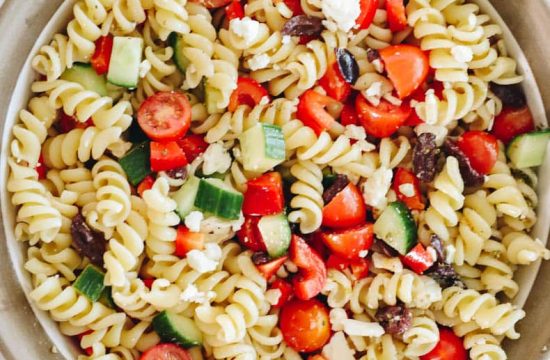Oh, glycemic regulation doesn’t seem that sexy to you? Trust us when we say this technical-sounding wellness topic is key to longevity and a svelte bod. This article is part two of yesterday’s story with Functional Medicine Registered Dietitian and founder of My Food is Health, Brigid Titgemeier.
Prioritize High Quality Sleep & Stress Reduction
An often overlooked ingredient to glycemic regulation and metabolic health is sleep. Research shows that when you sleep, you repair your cells, regulate your satiety hormones and improve your insulin sensitivity. Insufficient sleep is directly associated with an increased risk of obesity, type 2 diabetes and cravings. Lack of sleep increases the hunger hormone, ghrelin, and decreases the satiety hormone, leptin, which may lead you to make more impulsive food choices that are likely to be high glycemic foods. Think about times that you are sleep deprived and how much more likely you are to grab all of the starchy foods.

Rest and recovery are critical for settling cravings! Stress leads to an increased production of certain hormones, including cortisol, epinephrine and glucocorticoids. The stress response shuts down other hormones, such as insulin. When you’re stressed, the body wants to release rather than store glucose. The end result of these hormonal shifts is to allow more glucose into the bloodstream for energy. This happens even if you do not eat sugary foods!
Over time, chronic stress can keep blood sugar levels elevated. As a result, fat cells become less sensitive to insulin. This increases the body’s inclination to store fat and contributes to insulin resistance, where the cells no longer “hear” the signal of insulin. Simply stated, chronic stress can increase blood sugar levels and body fat accumulation.
Limit Added Sugar to No More than 1 Tbsp Per Day
One of the fastest ways to create quick spikes in your blood sugar levels is eating foods high in added sugars. This negatively impacts blood sugar levels and can increase output of a pro-inflammatory hormone called insulin, it can also deplete antioxidant levels and increase your production of reactive oxygen species. Limiting added sugars and eating a diet rich in antioxidants, on the other hand, can help neutralize or remove these free radicals and protect against oxidative stress.
Skip the Carbs on Carbs on Carbs
Creating balanced blood sugar levels requires consuming whole foods and cutting the highly processed foods and sugar beverages. The first step is eliminating highly processed foods and refined grains like white flour, white pasta, white rice that has been stripped of its outer layers.
The next step is to ensure you are not eating whole grains and other whole food sources of carbohydrates all in one sitting. Eating a whole foods diet that is higher in the glycemic load will still increase your blood glucose levels and thus, your insulin levels. This can make it difficult to move the needle in lowering your post-meal blood sugar response and can contribute to weight gain, decreased insulin sensitivity, pre-diabetes, and eventually even type 2 diabetes. Here are meal examples that are higher in moderate glycemic carbohydrates and low in protein and fat:
Bowl of oatmeal with 1 cup strawberries with almond milk
Bowl of quinoa with black beans and squash
Salad with dried cranberries, edamame, kidney beans, diced apple and vinaigrette
Smoothie with 1 apple, 1 cup spinach, 1 banana, 1 tbsp chia seeds, almond milk
If this is how you are structuring many of your meals, read on for my next tip!
Follow my Optimal Plate Method
The focus here is on eating well-balanced meals that taste great and offer nutritional components that allow your glucose response to be much lower compared to the meal examples in tip three. This helps you feel satisfied after you eat, avoid slumps in energy and lower inflammation associated with blood sugar fluctuations. Here is the general framework for my Optimal Plate Method:
Half of your plate with non-starchy vegetables
Ex: cauliflower, brussels sprouts, arugula, leafy greens, zucchini, tomatoes
A few thumbnails of healthy fats (1-2 tbsp)
Ex: extra virgin olive oil, avocado oil, nuts, seeds, avocado
3-6 oz high-quality protein
Ex: organic chicken or turkey, wild salmon, pasture-raised eggs, organic tofu, lentils
1 serving fiber-rich/starchy carbohydrates (optional)
Ex: sweet potatoes, potatoes, parsnips, quinoa, beans, apples, berries
Narrow your Window of Eating
Time restricted eating — or intermittent fasting — is the idea of narrowing your window of eating to prevent erratic eating at all hours of the day and night, supporting stable blood glucose levels. I recommend starting slow and committing to a 12 hour fasting schedule and a 12 hour eating schedule to start. For example, this would mean no food or drinks from 8pm until 8am, except for water. You may choose to gradually lengthen your window of fasting to 14-16 hours but pay attention to how you feel. If you have high levels of stress, exercise a lot, have low percent body fat and also eat a low carbohydrate diet, you may experience adverse effects from pushing your fasting window too long. Learn more about time restricted eating here.
Add 1-2 Tbsp Organic, Raw Apple Cider Vinegar 1-2 Times Per Day
Vinegar, when consumed before or with a meal can be associated with lower post-meal glucose levels, which helps keep insulin (and future food cravings) in check. The mechanism is not exactly clear but acetic acid, the key ingredient in apple cider vinegar and other vinegars, is thought to interfere with the breakdown of carbohydrates and/or promote glucose uptake by the muscle. Try adding 1-2 Tablespoons of organic, raw apple cider vinegar to 8 fluid ounces of water or adding it to your homemade salad dressings and marinades.
Share the post “6 Ways to Improve Your Glycemic Regulation (And Why It Matters)”











